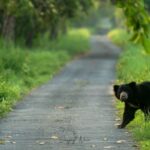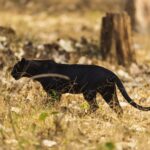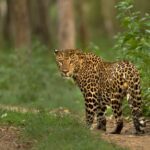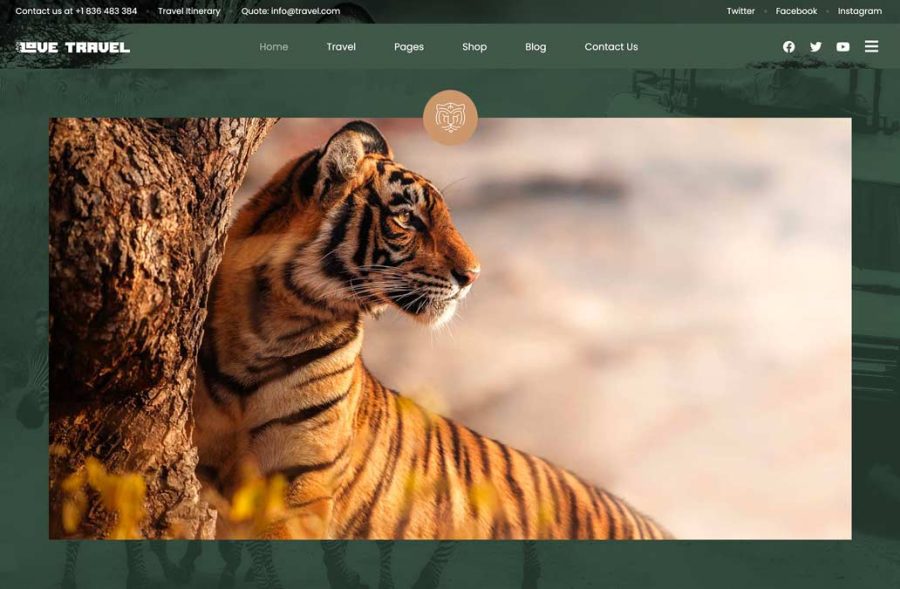Many travelers are unaware of the official Jim Corbett safari prices and booking structure, often paying more than necessary due to agents and touts.
Understanding the government-set rates and booking options for Corbett’s safaris, including Jeep and Canter safaris and stays in forest rest houses, can save you both money and time.
This guide covers each option in detail, including updated rates, the booking process, and the distinct features of Corbett’s diverse safari zones, helping you avoid unnecessary costs and make the most of your experience.
Jump To
ToggleAbout Jim Corbett National Park
Imagine the thrill of dawn breaking over Jim Corbett’s grasslands, with mist lifting from the valleys to reveal ancient trees and the call of a sambar deer alerting its herd to an approaching predator.
Jim Corbett National Park, established in 1936, is not only India’s oldest tiger reserve but a storied landscape where tigers, elephants, and over 600 bird species find refuge among dense forests and expansive riverbeds.
To fully savor this experience, understanding the park’s diverse zones, permit structures, Jim Corbett Safari Price, and unique habitats will help turn your safari into a truly immersive encounter with the wild.
Safari Options and Current Jim Corbett Safari Price (2024)
Jim Corbett offers two main ways to explore: by Jeep—a personal vehicle for close encounters—and by Canter, perfect for those seeking a broader, community experience. Here’s how the pricing works:
Jeep Safari Price: A Front-Row Ticket to Corbett’s Wild Heart
Jeep safaris offer access to Corbett’s legendary zones: Bijrani, Jhirna, Dhela, Garjia, Phato & Durga Devi. Each Jeep seats six and offers an experience closer to the forest floor, a prime vantage point for tiger sightings.
- Cost Breakdown:
- Permit: ₹3,600 per Jeep (up to six adults), covering entry to the park.
- Gypsy (Jeep) Rental: ₹2,800–₹3,000 for the session.
- Guide Fee: ₹700–₹800, payable on-site to certified guides.
- Approximate Total Cost: Around ₹7,100 to ₹7,400, shared among up to six people.
- Timings:
- Morning Safari: 6:00 AM to 9:30 AM
- Evening Safari: 2:30 PM to 5:30 PM
While government rates for permits and Jeeps are fixed, during peak times some drivers may expect additional tips. Booking through a knowledgeable operator familiar with Corbett’s workings can help ensure smooth sailing without unexpected costs in addition to the Jim Corbett Safari Price.
Canter Safari: The Gateway to Dhikala
For Dhikala, Corbett’s most iconic zone with its sprawling grasslands, a Canter Safari is your day-tripper’s ticket in. Each Canter accommodates 16 passengers, perfect for larger groups or solo travelers without private Jeep bookings.
- Jim Corbett Safari Price for Canter:
- Indian Nationals: ₹1,600 per person.
- Foreign Nationals: ₹3,000 per person.
- Safari Duration:
- Morning: 6:00 AM – 11:50 AM
- Afternoon: 12:00 PM – 6:00 PM
The Dhikala Canter Safari spans five hours, allowing you to immerse fully in one of India’s richest tiger habitats, where tiger and elephant sightings are common and each turn of the track reveals another marvel of the wilderness.
Pls note that you cannot do a gypsy safari in Dhikala, if you do not have a booking for overnight stay in one of the forest rest houses.
Jim Corbett Safari Zones and Their Unique Landscapes
Each safari zone in Jim Corbett National Park offers a unique wildlife experience, shaped by distinct landscapes and habitats. From Dhikala’s open grasslands, ideal for tiger sightings, to the birdwatcher’s haven in Durga Devi, every zone presents different wildlife encounters.
Understanding these differences not only enhances your safari experience but helps you choose the best zones for spotting specific animals, landscapes, or bird species that make Corbett so diverse.
Dhikala Zone
Dhikala, the beating heart of Corbett, stretches across vast grasslands where Bengal tigers and large herds of elephants roam free. Only visitors staying at one of Dhikala’s government-run forest lodges can book Jeep safaris, which makes it an exclusive experience.
Day visitors can enjoy this zone through a Canter safari, which traverses iconic open plains, dense sal forests, and riverbeds where crocodiles and gharials bask in the sun.
Known for high tiger and elephant sightings, Dhikala offers an expansive view of Corbett’s rich biodiversity.
Bijrani Zone
Bijrani’s lush grasslands and vast open dry riverbeds make it one of the most sought-after zones for tiger sightings, drawing visitors eager to spot the park’s apex predator. Once the tiger enters the river bed, you get ample time to click away.
Mornings here are particularly striking, with a landscape teeming with sambar deer and chital, the usual prey of the region’s tigers.
Bijrani’s well-planned trails maximize your chances of encountering not just tigers, but also leopards, elephants, and a rich variety of birds.
Garjia Zone
Garjia, a newer addition, is quickly becoming popular due to its varied terrain and easy accessibility from nearby resorts. This zone has a mix of dense forests and open fields, offering diverse wildlife, including tigers, leopards, and wild boars.
Its location near the Garjia Temple makes it convenient for visitors looking to combine wildlife viewing with cultural experiences.
Jhirna Zone
Unique among Corbett’s zones, Jhirna remains open year-round, offering a consistent chance to witness wildlife regardless of season. The landscape here combines scrublands, grass fields, and dense forests, supporting an array of animals from sloth bears to wild boars.
Jhirna is a favorite among birdwatchers, with ample sightings of species like parakeets, barbets, and various birds of prey.
Dhela Zone
Dhela, another recent addition, shares characteristics with Jhirna, featuring lush forest cover and wetlands. Known for its healthy population of elephants and bird species, Dhela’s mix of forests and water bodies makes it an excellent zone for varied sightings.
Winter visitors will find Dhela a paradise for spotting migratory birds in its marshes and wetlands.
Durga Devi Zone
Durga Devi is Corbett’s hilly zone, where rocky terrain and riverine forests create a distinct habitat. This zone is ideal for birdwatchers, with a chance to see rare species like the crested kingfisher and grey-headed fishing eagle.
While tiger sightings here are rare, leopards, otters, and even Himalayan black bears have been spotted in the deeper forest sections.
Phato Zone
Phato, one of the most recent zones opened to the public, offers a secluded safari experience with a high chance of tiger and elephant sightings. Its location near the Kalagarh Tiger Reserve adds to the wilderness feel, and the low visitor density makes it a rewarding choice for those looking for quieter safaris.
The zone is marked by dense woodlands and open patches, offering a blend of habitats that attract a variety of wildlife.
Best Gate in Jim Corbett
When planning a safari, we often hear, “We only want Dhikala! and nothing else” It’s no surprise—Dhikala has an incredible reputation with its open grasslands, river views, and high tiger density. Social media plays its part too.
But here’s the thing: almost every gate in Corbett offers a solid chance for wildlife sightings, often without the tight restrictions of Dhikala.
Consider Dhela Gate, for instance. It’s been a standout this season, drawing tiger sightings even during monsoon.
Then there’s Jhirna Gate, which is open all year, bringing you into lush, mixed terrain where you might spot everything from leopards to a variety of birdlife.
Garjia Gate is also a newer addition, granting access to unique landscapes and a quieter safari experience. So while Dhikala is popular, each gate holds its own promise of unforgettable wildlife encounters, often with fewer crowds and no less excitement.
Best Zone in Jim Corbett to Spot Tigers
For many visitors, Dhikala Zone is the holy grail for tiger sightings, and it does live up to its name with sprawling grasslands, a backdrop of the Ramganga, and regular tiger appearances. But—Dhikala is far from the only place to catch a glimpse of the elusive big cat.
Bijrani Zone is excellent for tiger sightings with its wide grasslands and forest patches.
Phato Zone has quickly become a favorite for summer safaris, known for daily tiger sightings near water sources, especially as temperatures soar.
This year, Dhela Zone has also gained traction, with a surprising number of tiger and elephant sightings even in wetter months. So while Dhikala is iconic, Corbett’s other zones like Bijrani, Phato, and Dhela give you that same heart-racing excitement, minus the crowd and exclusivity.
Conclusion – Lets Explore Corbett with Us
Embarking on a Jim Corbett safari is a journey into the heart of India’s wild, and with Safari Lab, your experience is guided by years of expertise.
From booking the right zone to ensuring a knowledgeable guide is by your side and being transparent about Jim Corbett Safari Price, Safari Lab takes the guesswork out of planning, offering a seamless and memorable encounter with the wilderness.
With intimate knowledge of Corbett’s landscapes and each zone’s unique wildlife patterns, our team provides a safari experience that respects the rhythms of the wild while maximizing your chance for unforgettable sightings. Join us for a truly immersive adventure into Jim Corbett’s remarkable ecosystem.



























